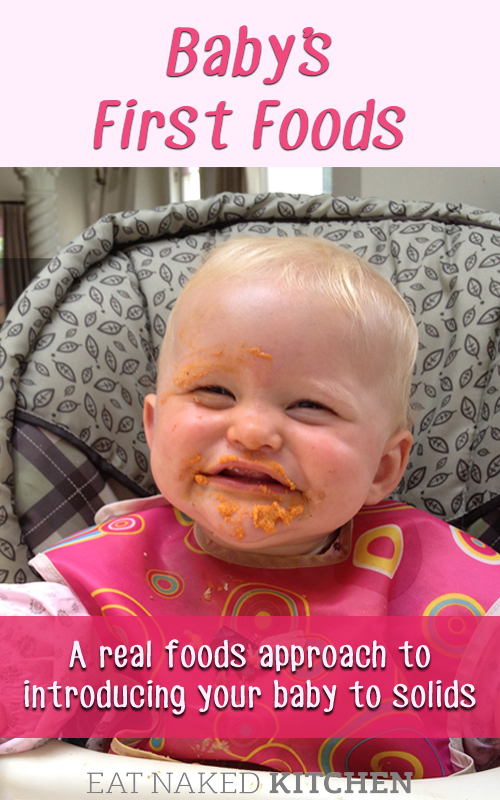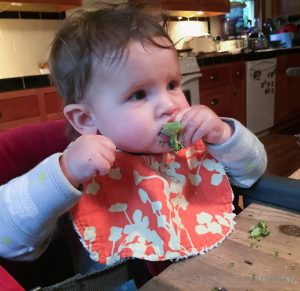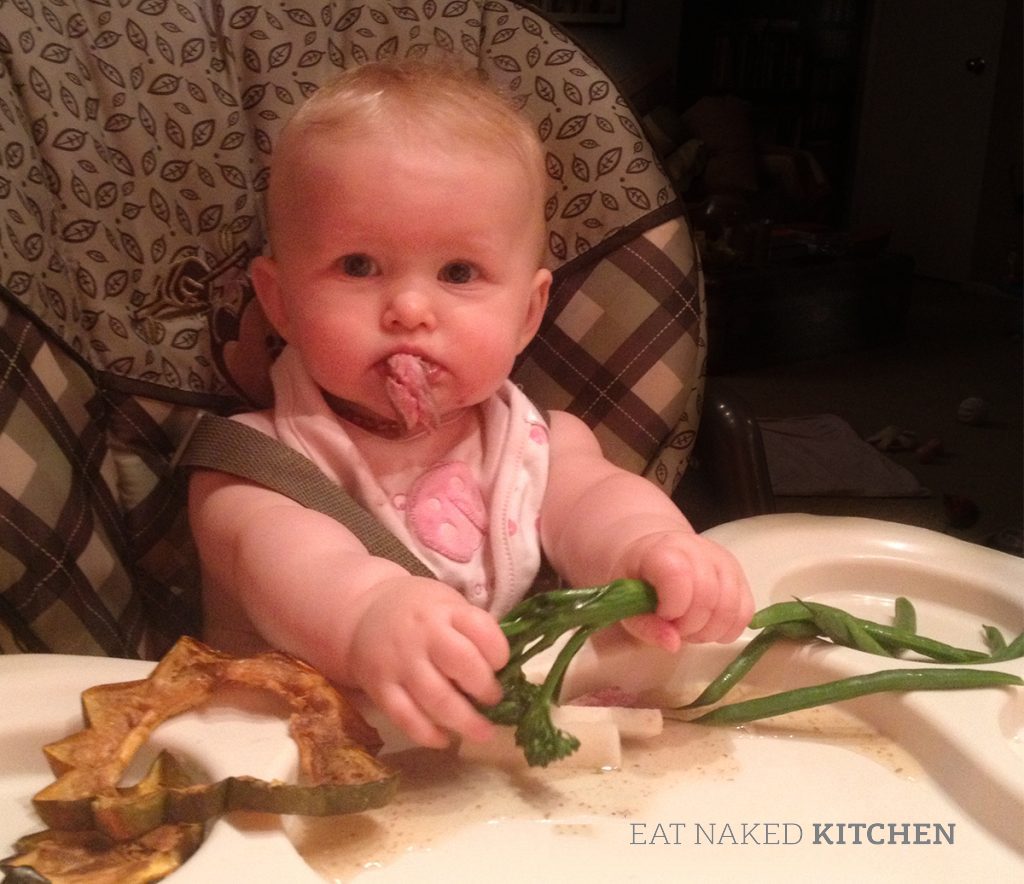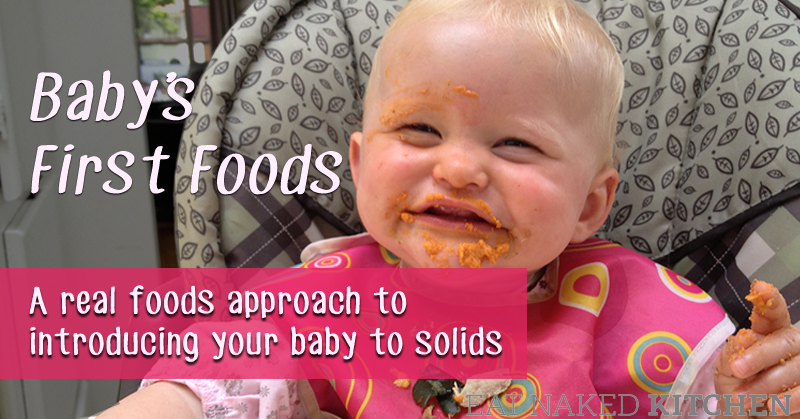I knew going into this whole parenting thing that I was woefully unprepared, but I figured at least I had the food part handled.
This is my thing, after all. What could be easier than introducing my littles to the wide and wonderful world of real food?
Turns out, it wasn’t as simple as I’d thought.
For one, the standard recommendations on what foods to introduce to your baby first make no sense to me as a nutritional therapy practitioner. Refined grains? Fortified cereals? These are some of the hardest foods to digest, loaded with synthetic nutrients and preservatives. A child’s digestive system doesn’t finish forming fully until they’re almost 2 years old. How can something this processed be a good idea?
Next, there’s the misnomer: we talk about “introducing solids”, but let’s face it – at 5, 6 or even 7 months old many babies don’t have any teeth yet, or only the front four, and so the food is hardly “solid”. It’s usually runny, or at the very least soft and squishy. A small deal, but I always found this confusing.
Then there’s the fact that trying anything new can be either an adventure or a really scary thing: so much of this depends on your baby’s personality. My first, Sia, simply loved to eat (still does). She was grabbing food out of our hands from 4 months old, and we barely had to do anything to inspire her to try new foods. Put it in front of her and down it went. I don’t know that we ever once spoon-fed her. We didn’t need to! We used the baby-led weaning method and she did it all herself.
Our second, Sasha, was really not that interested in food. She’d play with it, she’d squeeze it, she’d examine it… but she wouldn’t eat it. So we had to get a bit more creative with her. Baby-led weaning simply didn’t work. For her, we had to purée and spoon-feed (or finger-feed as the case may be – she preferred to suck things off our fingers than eat off a spoon).
And then there’s the pacing of it all: it’s tempting to go too quickly, to introduce several things at once. But if your baby reacts to something and you’ve introduced multiple things at the same time, you don’t know what caused the reaction and you have to eliminate everything you introduced and start over. This was something we found really challenging, especially for those first few foods before we had a lot of variety to choose from.

We’ve now gone through this twice personally and I’ve coached more clients than I can count through this process. While every baby responds to food differently, there are general guidelines that always apply:
1: Go slow
Only introduce one new food every four days. Introduce the food on day one, and then wait three days without introducing any other new foods, watching your baby closely for signs of an adverse reaction. If no adverse reaction, then it’s likely that food is safe to continue offering to her. If she has an adverse reaction, then leave the food out for another six weeks before trying again.
Here are the most common adverse reactions to watch for:
- Skin rashes including eczema, little pimples, diaper rash, and other “mystery” rashes
- Increased fussiness or a significant change in behavior
- Gastric upset: change in bowel patterns, increase in gas, mild diarrhea, spitting up the food
- Increased mucus production, runny nose, coughing
VERY IMPORTANT: If your baby is experiencing severe symptoms such as intense vomiting or diarrhea, respiratory distress, or hives, seek medical attention immediately and do NOT offer this food again without medical supervision.
At the beginning, this slow pace will feel incredibly challenging to maintain, especially if your baby is eager to explore food. But maintain it you must!
Keep a list of the foods you’ve introduced on hand. Post it on the fridge so all caregivers are aware of what foods have been introduced, what foods the baby tolerates well, and what foods need to be avoided.

2: Start with real food
One of the biggest critiques I have of many recommendations for first foods is that they’re not real food. Fortified rice cereal, for example, is a highly processed food, and not an optimal starting point. Here’s a list of first foods you can try:
- Meat stock or bone broth
- Steamed root veggies and tubers: carrots, beets, sweet potato, celeriac, parsnips, turnips, etc.
- Squashes: zucchini, spaghetti, acorn, kabocha, etc.
- Avocado
- Runny egg yolk (not the whites, which are highly allergenic and not well tolerated by many babies. Hold off on egg whites until your baby is over 1 year old)
- Puréed meats, or slow-cooked and extremely tender cuts of meat, minced into very small pieces
- Cooked greens puréed with some butter
- Organ meats! They’re some of the most nutrient-dense and important for the littles (as well as the rest of us, but babies haven’t developed an aversion to them yet 😉 )
- Fruits: stewed apples, pears or stone fruit (peaches, plums, etc), fresh banana.
Notice a theme here? Stick with simple, whole, fresh foods. Not packaged, fortified, processed foods.
For the first year, it’s also a good idea to avoid the more allergenic foods and those that are more difficult to digest. This means that for the first year you want to avoid all:
- Grains, nuts, beans, or seeds (other than pre-soaked chia seeds)
- Tomatoes
- Egg whites
- Honey
- Citrus
A very real benefit to starting with real food rather than processed, refined and fortified food products, is that you’re introducing your child to a variety of flavors, textures, and nutrients at a time when they are far more receptive to them. Building this foundation early is one of the most important things you can to to prevent future pickiness around food. The blander, the more refined, and the starchier the foods you start with, the more trouble you’re going to have with other more nutrient-dense, substantial, and flavorful foods later on.
3: Allow your baby the whole sensory experience

Whether you decide to try baby led weaning or spoon feed, letting your little one explore the food is a vitally important part of the process.
Let baby feel the food: squish it, smell it, lick it, pick at it… eating is a whole sensory experience, and part of making food accessible rather than frightening to a child is to allow them to explore it at their own pace.
If you’re following the baby-led weaning method, this will happen naturally. But even if you’re spoon feeding your baby, you can give them finger-sized portions lightly steamed and cooled so that they won’t burn the baby’s fingers, so he can play with the whole food, not just as a mash.
4: Make it tasty!
Don’t be afraid of flavor! There’s a broad misconception that babies need really plain, bland food, but that’s simply not the case. Without fail, every time one of our girls resists a food, if we add a yummy homemade sauce to it, they gobble it up. Of course you want to be mindful of the kind of sauce you give: something very spicy or garlicky is probably not the best starting point. But don’t be shy to make the food taste good. A little butter, salt and pepper go a long way!
You can actually train your baby to be more receptive to flavors by feeding mom a varied diet during her pregnancy and while breastfeeding. Several studies have shown that babies are more likely to respond positively to flavors they tasted via the amniotic fluid and breastmilk. We tried this on our two girls. I’ve never been a fan of spicy food and James was determined to have girls with a taste for spice. During my pregnancy with Sia, he fed me slowly spicier and spicier foods to increase my tolerance over those 9 months, and as a result she has a noticeably higher tolerance to spice than other children her age.
This strategy of adding flavor is another key element of minimizing future pickiness. The more flavor they experience at a young age, the less new and scary it will be down the road.
5: Eat together
As much as you can, have your baby eating ingredients or components of what the rest of the family is eating. This is such an important time to build the relationship with food and set a rhythm of family meals. Your baby wants to be a part of the family and eat the same foods everyone else is, so let her!
Some examples: if you’re having roast chicken dinner, cut up some really small pieces of chicken for her to nibble on, smash up some of the roasted sweet potato with some butter and let her play in it (Sia’s doing exactly that in the picture at the top of this post), and puree the greens the rest of the family is eating with some of the chicken juices. Now, even without teeth, your baby is having the same food as the rest of you! It means no double prepping two meals and a shared eating experience. Win, win, win.
Eating together as a family sets a really good tone for them as they grow up. Having the whole family share meals as much as possible establishes a rhythm and ritual around dinner time that has benefits far beyond your diet.
6: Try it seven times
Not all babies take to all foods immediately. In fact, it’s safe to say that most babies don’t take to new foods immediately. This can be discouraging at first, but remember that it can take multiple attempts before a baby will truly accept a new food and cut yourself some slack.
The general rule of thumb is to offer a new food seven times to your baby before setting it aside and determining that he doesn’t like it. And if you’ve tried it seven times, then don’t offer it again for a few weeks or months, but you can always try again later. Their taste buds are developing and evolving, and often foods they previously refused, when offered later, are well received.
What has your experience been? We’d love to hear from you of what has worked best when you first introduced foods to your little ones.







Trackbacks/Pingbacks